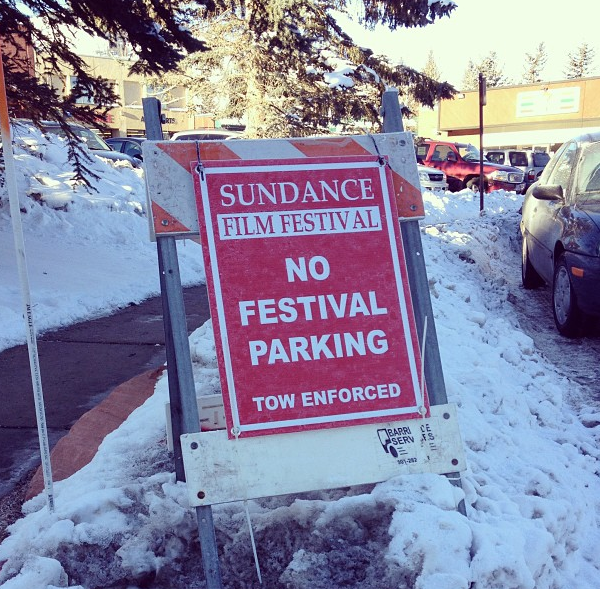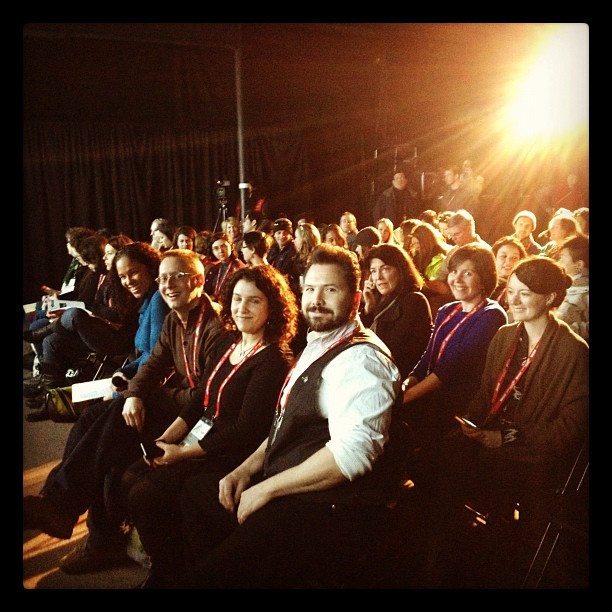19 Feb MIT at Sundance Roundup
We’ve had an exciting month here at the MIT Open Documentary Lab. In addition to braving the blizzard of the decade (it’s been a week since Nemo, and we’re still defrosting), the MIT team travelled to the 2013 Sundance Film Festival.
We caught some great docs, hosted a panel at the fabulous New Frontier exhibition, and blogged about the festival for Indiewire Magazine.
Here are some highlights:
The Magic of MIT
Photograph of the “Magic of MIT” panelists (R to L): the Media Lab’s Dan Novy, Open Documentary Lab Director Sarah Wolozin, MIT Center for Civic Media Co-PI Sasha Costanza-Chock, and Kamal Sinclair, senior manager of the New Frontier Story Lab. Photograph taken by the Media Lab’s Jessica Goldfin.
OpenDocLab Director Sarah Wolozin started her Sundance presentation with a provocation. “Digital technology can enable entirely new storytelling structures,” she said. Projects can use the web to explore new kinds of authorship, encourage viewer participation, or narrativize huge archives that might have previously been too vast for audience consumption. Wolozin went on to profile some of the storytelling projects at MIT. For example, Moments of Innovation, co-created with the IDFA DocLab, showcases the long history of the interactive documentary field, demonstrating that today’s projects have roots long before the rise of digital technology. The OpenDocLab’s “interactive white paper,” Moments of Innovation showcases documentary creativity across different media formats– the future of storytelling, in a certain sense, is older that one might think.
Wolozin emphasized story and audience alongside technology. Although MIT is known primarily as a technical institution, at the OpenDocLab, it always comes back to the people. “Thinking about how people will interact with a story should always be the starting point,” said Wolozin. OpenDocLab collaborator and co-PI of the MIT Center for Civic Media Sasha Costanza-Chock discussed some of those new kinds of interaction in his presentation on participatory media-making. Collaborative projects like SandyStoryline and VozMob, according to Costanza-Chock, are helping people take control of the tools of media creation–using them to capture and spread their own stories.
The always-incredible Dan Novy literally made my jaw drop when he went through the projects he’s working on with the MIT Media Lab’s Object-Based Media group. Did you know it was technically possible to have a “context-aware” projector that recognized your voice and threw up images representing the words you said? Me neither. But Object-Based Media’s “Narratarium” does all this and more. According to the project page,
Narratarium is an immersive storytelling environment to augment creative play using texture, color, and image. We are using natural language processing to listen to and understand stories being told, and thematically augment the environment using color and images. As a child tells stories about a jungle, the room is filled with greens and browns and foliage comes into view. A traveling parent can tell a story to a child and fill to room with images, color, and presence.
Wow! Although this technology is a few years down the pike, I can only imagine the types of immersive and interactive stories it could facilitate.
Creating Critics
Julie Fischer and I had the opportunity to blog about the fantastic projects at Sundance’s New Frontier exhibition for Indiewire Magazine’s Criticwire blog, as part of a “Creating Critics” initiative, designed to help graduate students learn how to critique digital projects.
Taken as a whole, New Frontier provided a glimpse of some of the directions storytelling might be headed in the future. “Our job is to stay abreast of innovations in storytelling,” said curator Shari Frillot. “As the media landscape changes, it’s profoundly affecting how we tell our stories.” Although many people think of New Frontier as “art at Sundance,” Frilot continued, the exhibition is really about “expanding cinematic storytelling.”
[vimeo]http://vimeo.com/57635423[/vimeo]
Julie profiled “What’s He Building in There,” a narrative 3D projection that covered the exterior of the New Frontier exhibition Hall.
The unique feature of “What’s He Building In There?” is that in opening itself to being less immersive — in an outdoor space subject to noise, interruption and people passing through — it becomes thoroughly communal. Viewers can mingle and chat, while grabbing a bite to eat at one of the conveniently situated food trucks or under the coveted glow of a heat lamp. They can point out a newly discovered detail to their friends. The loose narrative of the work gives viewers toeholds to engage with it and to get others around them to engage, too. It invites viewers to nudge each other and whisper under their breath about what they think is going on. And that seems like an immersion of a different kind, a means of using physical space for cinematic involvement that is built by the audience together. Viewers are drawn into the piece not just for its dark charms alone, but for the thrill of pondering the question on everyone’s mind: “What is he building in there?”
Julie also took a look at the New Frontier project “Coral: Rekindling Venus,” an immersive documentary and augmented reality app centering on coral reefs.
Strengthening the relationship between the human world and the globe’s endangered coral reefs is the mission of the piece. Inspired by the global cooperation of the 18th Century scientific community, which rallied together to observe the movement of Venus across the sun from points across the globe, Wallworth saw 2012’s recurrence of that natural phenomenon as the perfect time to bring together her artistic rallying cry for a similarly global connection to the world’s oceans. Beyond the temporal significance, there is the deep connection between sea and space at work in the piece, fusing the imaginative allure of two mysterious realms that have long fascinated humankind. Within the bubble of the planetarium dome, watching bioluminescent specks in the darkness of the deep sea fan out in constellations, the conceptual richness of Wallworth’s vision is undeniable.
In her review of “Google and the World Brain,” a feature-length documentary centering on freedom of information, Julie discussed the relationship between web filmmaking and cinematic storytelling.
Web-native interactive documentaries are coming into their own. Two of the best-known projects were featured at Sundance through support from the festival’s New Frontier section: the moving and brilliantly participatory “18 Days in Egypt” in 2011, and the imaginative, engaging interactive nature saga “Bear 71″ in 2012. These works are dramatically engrossing in two very different ways. The burgeoning web documentary scene is quickly discovering a myriad more ways to work the web into creative, immersive storytelling experiences.
But there is a reason that the highest praise many of these works receive is to be called “cinematic.” While some interactive storytelling works soar to new and unexpected reaches of immersion and impact, others fall flat. There is craftsmanship in synthesizing information and emotional expression — be it a book, a film, or an interactive web-based experience. “A book is not an extra-long Tweet,” says “Google and the World Brain” interviewee Jaron Lanier, getting a laugh.
I wrote about Meredith Danluck’s “North of South, East of West,” a four-channel film inspired by contemporary TV that screened at New Frontier.
Despite its measured pace, “North of South, East of West” builds to a climax worthy of the most nail-biting TV show. Celebrating television’s continuing storylines, Danluck denies her audience a simple ending. “In a traditional narrative structure, there’s resolution,” she said. “Episodic narrative ends on plot point two without any resolution.” With their stories suspended midstream, the characters of “North of South, East of West” challenge the film’s audience to engage with their continuing story, as well as their lives beyond the screen.
“Pulse Index” was an interactive installation that created covered the walls of New Frontier with the fingerprints of exhibition visitors.
While Jonathan Harris’s “We Feel Fine” engages with emotion in a cognitive way — quantifying how many people “feel” a certain way at a given point — “Pulse Index” uses quantitative data to create an emotional effect. Built using the heartbeats and fingerprints of recent visitors, some of whom may still be in the room, the piece has an immediacy and emotional intimacy that’s hard to quantify. The fingerprints, some stretched as large as floor-to-ceiling, bathe the room in a warm, welcoming light. Standing in the middle of “Pulse Index,” surrounded by the softly glowing fingerprints of visitors who came before, it’s hard not to feel part of a spontaneous community.
Audrey Ewell and Aaron Aites of the crowdsourced documentary “99%: The Occupy Wall Street Collaborative Film” were kind enough to talk about their process, as well as the rewards and challenges of undertaking a crowdsourced project.
“Everything we did up until we started editing was built to incorporate many voices,” said Aites. “All the systems we set up were designed to make collaboration possible.” To see the film to completion, Ewell and Aites coordinated a network of contributors across the United States. The film’s diversity of voices enabled its sweeping scope: a co-director based in the U.S. South, worked on a segment about poverty in Mississippi. A collaborating war photographer profiled veterans involved with Occupy. “People brought their own backgrounds and ideas to the topic, and really enriched the film,” added Ewell.
Read more at the OpenDocLab, or at Indiewire’s Criticwire blog.





